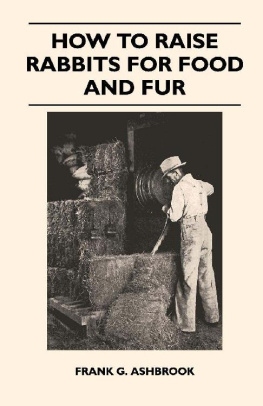Jay L. Lush - Animal Breeding Plans
Here you can read online Jay L. Lush - Animal Breeding Plans full text of the book (entire story) in english for free. Download pdf and epub, get meaning, cover and reviews about this ebook. year: 2013, publisher: Read Books Ltd., genre: Art. Description of the work, (preface) as well as reviews are available. Best literature library LitArk.com created for fans of good reading and offers a wide selection of genres:
Romance novel
Science fiction
Adventure
Detective
Science
History
Home and family
Prose
Art
Politics
Computer
Non-fiction
Religion
Business
Children
Humor
Choose a favorite category and find really read worthwhile books. Enjoy immersion in the world of imagination, feel the emotions of the characters or learn something new for yourself, make an fascinating discovery.

- Book:Animal Breeding Plans
- Author:
- Publisher:Read Books Ltd.
- Genre:
- Year:2013
- Rating:5 / 5
- Favourites:Add to favourites
- Your mark:
- 100
- 1
- 2
- 3
- 4
- 5
Animal Breeding Plans: summary, description and annotation
We offer to read an annotation, description, summary or preface (depends on what the author of the book "Animal Breeding Plans" wrote himself). If you haven't found the necessary information about the book — write in the comments, we will try to find it.
Animal Breeding Plans — read online for free the complete book (whole text) full work
Below is the text of the book, divided by pages. System saving the place of the last page read, allows you to conveniently read the book "Animal Breeding Plans" online for free, without having to search again every time where you left off. Put a bookmark, and you can go to the page where you finished reading at any time.
Font size:
Interval:
Bookmark:
BREEDING
PLANS
By JAY L. LUSH
This book has grown out of seven years of teaching animal breeding to college students who have already had courses in genetics, embryology, anatomy, and physiology of farm animals, herdbook study, history of breeds, and stock judging. The object of this course is to give the students a clear understanding of the means available for improving the heredity of farm animals, more especially of what each possible method will or will not do well.
No effort of mine could keep the book entirely free from statistical terms. After all, a breed is a population, and any attempt at precision in discussing methods of changing its characteristics must necessarily be phrased in terms of the measurements of populations; that is, in terms of averages and of variability. Complete proofs have been presented only where those were simple and brief. In other cases I have sought to present only enough to indicate the outline of the argument and its essential reasonableness. That, of course, involves more facts and formulas than most students will ever again use in actual practice but not, I think, more than are necessary to help the student understand, at least in a qualitative way, why each breeding method he might use is effective in doing certain things and practically powerless to do other things.
Animal breeding is a business; and, therefore, economic considerations of the value and availability of time and materials loom much larger in it than they do in a pure science. The work must go on, and decisions must be made in many cases where there is not yet enough evidence to show with certainty what the result will be. The scientist, faced with the problem of deciding what is the truth in such a case, might retire to his laboratory and design an experiment which in due time would reveal that truth. But the man engaged in the business of animal breeding cannot wait for that. Without being entirely certain of what would result from each of the alternatives open to him, he must decide whether to cull or keep each animal and whether to mate it in this way or in that. Knowing that the odds are two to one in favor of one procedure as against another may be highly useful to him as a business man, although the scientist may well demand that the odds be higher than the conventional 19 to 1 before he places much faith in a principle deduced from his experimental data. With these needs of the practical breeder in mind, I have sought to state the most probable truth concerning questions which may guide his actual decisions, even in cases where genetic knowledge has not yet established the limits of that truth as closely as is desirable for scientific purposes. Such statements have been labeled with qualifying phrases so that the students will be prepared to encounter occasional exceptions to them.
The ideas in this book have been drawn freely from the published works of many persons. I wish to acknowledge especially my indebtedness to Sewall Wright for many published and unpublished ideas upon which I have drawn, and for his friendly counsel about many detailed problems during more than a dozen years.

Progress in animal breeding during the last six years has been enough that the necessity for a third printing of this book makes desirable its revision to include the newer developments which seem practically important and to rephrase and illustrate with more examples some of the less easily understood but important ideas for which simpler ways of expression have been found.
Changes have been extensive in . Also the former single chapter on how selection changes a population has been divided into two, the more clearly to emphasize the contrast between the underlying genetic principles which are responsible and the outward results which the breeder actually sees. The discussions of selection indexes, of progress to be expected under various conditions of selection, and of how to form distinct families and use them efficiently as part of the basis for selection have been considerably expanded. The work in the regional laboratories for breeding swine, sheep, and poultry has already stimulated progress in these fields by making it necessary for the investigators often to devise and use measures, scores, and other techniques even before the underlying principles of those methods were wholly clarified. That in turn has demanded an early checking and testing of whether those methods really worked as it was thought they would, and of whether their principles were correctly understood.
Ames, Iowa.
December, 1942
JAY L. LUSH
BACKGROUND OF ANIMAL BREEDING
GENETIC PRINCIPLES IN ANIMAL BREEDING
BREEDING PLANS BASED ON SELECTION
BREEDING PLANS BASED ON RELATIONSHIP
BREEDING PLANS BASED ON SOMATIC LIKENESS
OTHER TOPICS CONCERNING BREEDING PLANS
TOPICS RELATING TO REPRODUCTION
SUMMARY
The story of the origin and domestication of farm animals, although interesting, has little practical usefulness to the animal breeder who is seeking to better his flocks and herds today. Only living animals can be used for breeding; and if those have the inheritance the breeder wants and can produce fertile offspring, it makes little difference how they came by that inheritance or what their ancestors were. Knowledge of how closely two races of animals are related may be of some help in forecasting the outcome of crosses between them; but such predictions, based on degree of relationship, will have many exceptions. Knowledge of the origin of farm animals, therefore, is useful to the practical breeder only in the same way that ancient history may be useful in training modern people for citizenship. The details matter not at all, but here and there the history may show with dispassionate clearness some general principle of human conduct which will repeat itself in present situations. Also, it may give the student a perspective which will be useful in making decisions concerning contemporary affairs. The present chapter, then, is a compilation of facts which may be helpful in forming a historical perspective from which to view the present general problems of animal breeding. The reader seeking only immediately useful information is advised to omit it or glance at it but hastily.
Domestication of the important farm animals was accomplished long before the beginning of written history, but long after man had become a toolmaker and tool-user of considerable skill. In terms of human culture it seems to have happened mostly very late in the Paleolithic (Old Stone Age) or early in the Neolithic (New Stone Age), although this varied with different peoples in different parts of the world.
The origin of the species of animals which were domesticated extends back into vastly greater reaches of time and is only a special aspect of the story of evolution. is intended to show graphically the contrasts in the enormously long time involved in evolution, the comparatively short time which has elapsed since domestication first took place, and the tiny fraction of time since definite and continuous written history began.
The following comments concerning geologic and cultural time are centered around the mammals and man, since those are the central figures in the story of domestication. There are hundreds of thousands of species in the animal kingdom; but with a few exceptions, such as honeybees and silkworms, all the domesticated animals are included in a few species of mammals and birds. It is an interesting but perhaps an idle speculation to wonder why so few species were domesticated. Did the mental characteristics of the others make domestication impossible? Or did those which were domesticated have among them nearly all the characteristics which man found useful to him? Why did not man domesticate any of the many species of animals which hibernate through the winter? Those would have had some practical advantages in regions where feed is abundant from spring to fall, but scarce or buried during the winter. Are there perhaps still unrealized possibilities which can be had by domesticating species which are still wild or semi-wild?
Font size:
Interval:
Bookmark:
Similar books «Animal Breeding Plans»
Look at similar books to Animal Breeding Plans. We have selected literature similar in name and meaning in the hope of providing readers with more options to find new, interesting, not yet read works.
Discussion, reviews of the book Animal Breeding Plans and just readers' own opinions. Leave your comments, write what you think about the work, its meaning or the main characters. Specify what exactly you liked and what you didn't like, and why you think so.



